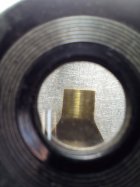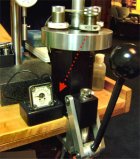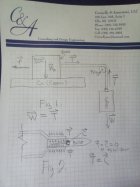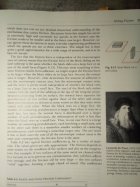You are correct.
We have no way to measure tension right now.
Seating force and tension are separate and different.
By normalizing friction, which a carbon layer does, we can see tension
variances using seating or pre-seating forces.
Correct also.
Bullets are normally neck released based on tension, regardless of dry neck friction.
I use a Sinclair mandrel die with a button load cell above the mandrel, that the mandrel raises against.
View attachment 1560310
SF (static friction) = CSf x Weight
Kf (kinetic friction) = CKf x Weight
Tension = Weight from Fig 1 in attachment
If your load cell reads 120lbs max at seating, you are measuring the Kf (kinetic friction force)! Therefore, The Tension force of the neck = 120lbs ÷ 1.0 (copper on copper kinetic frictional coeffient)!!!
The neck tension is 120 lbs!!!!
To break the static friction force (bullet release force) of the equalized state of opposing forces (bullet compression = neck tension in figure 2 in attachment) you need 120lbs (tension) x 1.6 (copper on copper static frictional coefficient) = 192 lbs of force!!! As you can see, static friction is much greater than kinetic friction!!
You have the tools to measure Neck Tension and need to use mathematics and physics to find that values!!! The biggest problem is finding the coefficients of static and kinetic friction of copper on carbon!!
You have the tools, just need to find or test to find the factorial constants!!! Let's ball park this issue and use Mark's (quest450) curves on bare brass vs 6x fired carbon coated neck curves!!! Using 1 for copper on copper KCOf at around 130lbs and 6x at around 40lbs!! Without true data and stats, THIS IS BALL PARK CALCULATIONS AND ASSUMPTIONS!!! I did a rough ratio calc of .308 for K copper on carbon!!! Lets look at around his 40lb seating force!!! Mark's tension is around 40lbs/.308 = 130lbs!! Very close to the 120lbs from the 1st calc above!! Well within 10% error!!! DOES THE CARBON INCREASE THE TENSION???? Or is my guess off!! His static friction would be (Ratio assumed value for SCOf) is 0.5!!! Very close since carbon has a lot more surface area than brass!! Marks assumed by double ratio best guesses static friction is 230lbs!!
Using Mark's static friction solution of 230lb, we can find the pressure required to release that bullet using the formula
P (pressure to release the bullet) = Force (Static friction) ÷ A (area of base face of the bullet)!!
P = 230 ÷ ((caliber/4)squared x π)
For a 6.5 bullet, the bullet release pressure is 16,807psi on the base of the bullet!! Let's look at its position on the chamber pressure curve with a peak pressure of 55,000psi!! It is 30.6% or just a little under the 1/3th up from the very start of up sloping pressure curve!!!
Does the neck expand before the bullet is released??
Let's assume a neck thickness of 12 thou and minimal neck camber bore clearance of 3 thou!!! The OD of neck for a 6.5 would be .288 with a neck chamber bore of .291!! The area in question is the neck chamber bore area - neck OD area!!
0.133 sqin - 0.130 sqin = 0.003 sqin
The force on that area when the bullet is released is 16,807psi x 0.003 sqin = 50lbs!!
The neck tension is 4.6 times greater than the pressure force on this region in question!!! The neck keeps its bullet seating form at bullet release pressures!! This is why there are carbon deposits on the outside of the neck after firing due to the turbulent flow of the remain gases exhausting before the neck is expanded by the higher pressures following bullet release!!
I have worked with engineering and physics for over 45 years!! Performed consulting engineering solutions (will working for Connelly & Associates) at Swift Bullet in Quinter, KS on lead core extrusion thermal problems and hazardous exhaust air capture system component changes to exceed new EPA air emissions standards and limits in their ballistic tunnel!! Most of the problems on forums are really easy and common problems from day to day at work!!! Retired now and want to pass my knowledge and experiences with form members to improve their knowledge and experience in shooting sports!!! With 105 credit hours of applied science courses, I can say, I KNOW A LITTLE OF EVERYTHING, AND A LOT OF NOTHING!!!
Aim Small, Hit Big!!!
BILL
I just realized your load cell is on a mandrel!! If you could get a gliden copper mandrel of exact bullet diameter you could measure the static friction force directly!!! Seat the copper mandrel after Sinclair mandrel forming, where the chamfer/main shaft is a hair below the neck/shoulder junction! Let it rest for a minute or two to allow compression and tension equalization!!! Then watch the meter for peak static break as you slowly add more downward force on the copper mandrel!!! That is the same force of the bullet release!!! You have the right tool, just need a copper mandrel for testing!! But, you have to reform and Sinclair mandrel on all tested brass!!!














